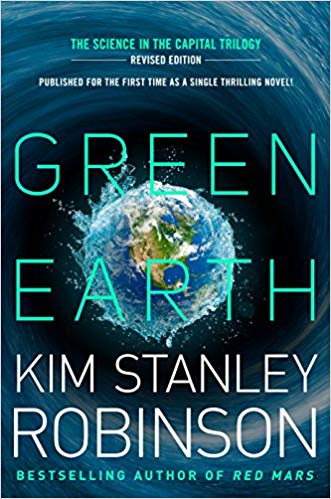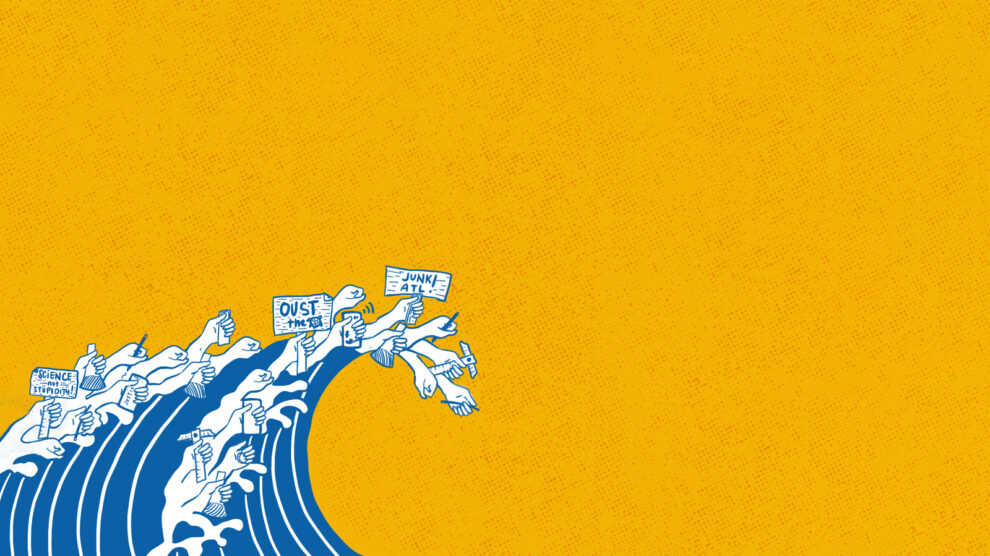An Excerpt from Green Earth
By Kim Stanley Robinson
Kim Stanley Robinson describes himself as “a patriot of the genre” of science fiction, writing at the intersection of science and politics for over three decades. His work is striking for its warmth and realism. The realism that underlies his work comes out of a dedication to thorough scientific and historical research, complex characterization, and one of the keenest understandings of the forces that shape politics in the real world that can be found in any genre of writing. Its warmth comes from a equally unwavering dedication to struggle for a just and humane world in the face of those forces.
Of Stan’s work, Green Earth–part of his Science in the Capital series–feels closest to home, taking place in a time adjacent to our own, where only the prospect of a looming ecological crisis can shake late-capitalist society out of political and bureaucratic morass. While these passages don’t directly mention geoengineering, we include them because they illustrate the circumstances under which scientists might find themselves gang-pressed to support geoengineering because “there is no alternative.” Without a firm understanding of the political nature of science, the options that capitalist society offers might seem to a “neutral” observer like the only ones. We know that’s not true. Scientists themselves can and must provide alternatives to the stacked deck of choices before us.
We extend our deepest gratitude to Stan for allowing us to include these passages in our return to publication, and we hope that you find them illuminating.
—Andrew Foltz-Morrison
Chapter 9: Trigger Event
Department of Homeland Security
CONFIDENTIAL
Transcript 3957396584
Phones 645d/922a
922a: Frank are you ready for this?
645d: I don’t know, Kenzo, you tell me.
922a: Casper the Friendly Ghost spent last week swimming over the sill between Iceland and Scotland, and she never got a salinity figure over 34.
645d: Wow. How deep did she go?
922a: Surface water, central water, the top of the deep water. And never over 34. 33.8 on the surface once she got into the Norwegian Sea.
645d: Wow. How about temperatures?
922a: 0.9 on the surface, 0.75 at three hundred meters. Warmer to the east, but not by much.
645d: Oh my God. So it’s not going to sink.
922a: That’s right.
645d: What’s going to happen?
922a: I don’t know. It could be the stall.
645d: Someone’s got to do something about this.
922a: Good luck my friend! I personally think we’re in for some fun. A thousand years of fun.
“Science Has To Insist On Itself”
The rest of the crowd trickled in. NSF’s Board of Directors was composed of twenty-four people, although usually there were a couple of vacant positions in the process of being filled. The directors were all powers in their parts of the scientific world, appointed by the President from lists provided by NSF and the National Academy of Science, and serving four-year terms.
Now they were looking wet and windblown, straggling into the room in ones and twos. Some of Anna’s fellow division directors came in as well. Eventually fifteen or sixteen people were seated around the big table, including Sophie Harper, their congressional liaison. The light in the room flickered faintly as lightning made itself visible diffusely through the coursing rain on the room’s exterior window. The gray world outside pulsed as if it were an aquarium.
Diane welcomed them and moved quickly through the agenda’s introductory matter. After that she ran down a list of large projects that had been proposed or discussed in the previous year, getting the briefest of reports from Board members assigned to study the projects. They included climate mitigation proposals, many highly speculative, all extremely expensive. A carbon sink plan included reforestations that would also be useful for flood control; Anna made a note to tell the Khembalis about that one.
But nothing they discussed was going to work on the global situation, given the massive nature of the problem, and NSF’s highly constricted budget and mission. Ten billion dollars; and even the $50 billion items on their list of projects only addressed small parts of the global problem.
At moments like these Anna could not help thinking of Charlie playing with Joe’s dinosaurs, holding up a little pink mouselike thing a first mammal, and exclaiming, “Hey it’s NSF!”
He had meant it as a compliment to their skill at surviving in a big world, or to the way they represented the coming thing, but unfortunately the comparison was also true in terms of size. Scurrying about trying to survive in a world of dying dinosaurs- worse yet, trying to save the dinosaurs too- where was the mechanism? As Frank would say, How could that work?
She banished these thoughts and made her own quick report, about the infrastructure distribution programs that she had been studying. A lot of infrastructure had been dispersed in the last decade. Anna’s concluding suggestion that the programs were a success and should be expanded was received with nods all around, as an obvious thing to do. But also expensive.
There was a pause as people thought this over.
Finally Diane looked at Frank. “Frank, are you ready?”
Frank stood to answer. He did not exhibit his usual ease. He walked over to the whiteboard, took up a red marker, fiddled with it. His face was flushed.
“All the programs described so far focus on gathering data, and the truth is we have enough data already. The world’s climate has already changed. The Arctic Ocean ice pack breakup has flooded the surface of the North Atlantic with fresh water, and the most recent data indicate that that has stopped the surface water from sinking, and stalled the circulation of the big Atlantic current. That’s been pretty conclusively identified as a major trigger event in Earth’s climatic history. So, abrupt climate change has almost certainly already begun.”
Frank stared at the whiteboard, lips pursed. “So. The question becomes, what do we do? Business as usual won’t work. For you here, the effort should be toward finding ways that NSF can make a much broader impact than it has till now.”
“Excuse me,” one of the Board members aid, sounding a bit peeved. He was a man in his sixties, with a gray Lincoln beard; Anna did not recognize him. “How is this any different from what we are always trying to do? I mean, we’ve talked about trying to do this at every Board meeting I’ve ever been to. We always ask ourselves, how can NSF get more bang for its buck?”
“May be so,” said Frank. “But it hasn’t worked.”
Diane said, “What are you saying, Frank? What should we be doing that we haven’t already tried?”
Frank cleared his throat. He and Diane stared at each other for a long moment, locked in some kind of undefined conflict.
Frank shrugged, went to the whiteboard, uncapped his red marker. “Let me make a list.”
He wrote a 1 and circled it.
“One. We have to knit it all together.” He wrote, “Synergies at NSF.”
“I mean by this that you should be stimulating synergistic efforts that range across the disciplines to work on this problem. Then,” he wrote and circled a 2, “you should be looking for immediately relevant applications coming out of the basic research funded by the foundation. These applications should be hunted for by people brought in specifically to do that. You should have a permanent in-house innovation and policy team.”
Anna thought, That would be that mathematician he just lost.
She had never seen Frank so serious. His usual manner was gone, and with it the mask of cynicism and self-assurance that he habitually wore, the attitude that it was all a game he condescended to play even though everyone had already lost. Now he was serious, even angry it seemed. Angry at Diane somehow. He wouldn’t’ look at her, or anywhere else but at his scrawled red words on the whiteboard.
“Third, you should commission work that you think needs to be done, rather than waiting for proposals and funding choices given to you by others. You can’t afford to be so passive anymore. Fourth, you should assign up to fifty percent of NSF’s budget every year to the biggest outstanding problem you can identify, in this case catastrophic climate change, and direct the scientific community to attack and solve it. Both public and private science, the whole culture. The effort could be organized like Germany’s Max Planck Institutes, which are funded by the government to go after particular problems. There’s a bout a dozen of those, and they exist while they’re needed and get disbanded when they’re not. It’s a good model.
“Fifth, you should make more efforts to increase the power of science in policy decisions everywhere. Organize all the scientific bodies on Earth into one larger body, a kind of UN of scientific organizations, which then would work together on the important issues, and would collectively insist they be funded, for the sake of all the future generations of humanity.”
He stopped, stared at the whiteboard. He shook his head. “All this may sound, what. Large-scaled. Or interfering. Antidemocratic, or elitist or something–something beyond what science is supposed to be.”
The man who had objected before said, “We’re in no position to stage a coup.”
Frank shook him off. “Think of it in terms of Kuhnian paradigms. The paradigm model Kuhn outlined in The Structure of Scientific Revolutions.”
The bearded man nodded, granting this.
“Kuhn postulated that in the usual state of affairs there is general agreement to a set of core beliefs that structure people’s theories- that’s a paradigm, and the work done within it he called ‘normal science.’ He was referring to a theoretical understanding of nature, but let’s apply the model to science’s social behavior. We do normal science. But as Kuhn pointed out, anomalies crop up. Undeniable events occur that we can’t cope with inside the old paradigm. At first scientists just fit the anomalies in as best they can. Then when there are enough of them, the paradigm begins to fall apart. In trying to reconcile the irreconcilable, it becomes as weird as Ptolemy’s astronomical system.
“That’s where we are now. We have our universities, and the Foundation and all the rest, but the system is too complicated, and flying off in all directions. Not capable of coming to grips with the aberrant data.”
Frank looked briefly at the man who had objected. “Eventually, a new paradigm is proposed that accounts for the anomalies. It comes to grips with them better. After a period of confusion and debate, people start using it to structure a new normal science.”
The old man nodded. “You’re suggesting we need a paradigm shift in how science interacts with society.”
“Yes I am.”
“But what is it? We’re still in the period of confusion, as far as I can see.”
“Yes. But if we don’t have a clear sense of what the next paradigm should be, and I agree we don’t, then it’s our job now as scientists to force the issue and make it happen, by employing all our resources in an organized way. To get to the other side faster. The money and the institutional power that NSF has assembled ever since it began has to be used like a tool to build this. No more treating our grantees like clients whom we have to satisfy if we want to keep their business. No more going to Congress with hat in hand, begging for change and letting them call the shots as to where the money is spent.”
“Whoa now,” objected Sophie Harper. “They have the right to allocate federal funds, and they’re very jealous of that right, believe you me.”
“Sure they are. That’s the source of their power. And they’re the elected government. I’m not disputing any of that. But we can go to them and say, Look, the party’s over. We need this list of projects funded or civilization will be hammered for decades to come. Tell them they can’t give a trillion dollars a year to the military and leave the rescue and rebuilding of the world to chance and some kind of free market religion. It isn’t working, and science is the only way out of the mess.”
“You mean the scientific deployment of human effort in these causes,” Diane said.
A discussion followed. People threw out ideas: creating a kind of shadow replacement for Congress’s Office Technology Assessment; campaigning to make the President’s scientific advisor a cabinet post; even drafting a new amendment to the Constitution that would elevate a body like the National Academy of Science to the level of a branch of government. Then also going international, funding a world body of scientific organizations to push everything that would create a sustainable civilization. These ideas and more were mooted, hesitantly at first, and then with more enthusiasm as the people there began to realize that they all had harbored various ideas of this kind, visions that were usually too big or strange to broach to other scientists. “Pretty wild notions,” as one of them noted.
Frank had been listing them on the whiteboard. “The thing is,” he said, “the way we have things organized now, scientists keep themselves out of political policy decisions in the same way that the military keeps itself out of civilian affairs. That comes out of World War Two, when science was part of the military. Scientists recused themselves from policy decisions, and a structure was formed that created civilian control of science, so to speak.
“But I say to hell with that! Science isn’t like the military. It’s the solution, not the problem. And so it has to insist on itself. That’s what looks wild about these ideas, that scientists should take a stand and become a part of the political decision-making process. If it were the folks in the Pentagon saying that, I would agree there would be reason to worry, although they do it all the time. What I’m saying is that it’s a perfectly legitimate move for us to make, even a necessary move, because we are not the military, we are already civilians, and we have the only methods in existence that are capable of dealing with these global environmental problems.”
Further Reading
Find a copy of Green Earth at your local bookstore here.
Read more from Kim Stanley Robinson on geoengineering in this interview with Huffington Post.






